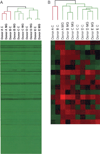Gene expression profiling of extracellular matrix as an effector of human hepatocyte phenotype in primary cell culture
- PMID: 17329237
- PMCID: PMC4098128
- DOI: 10.1093/toxsci/kfm034
Gene expression profiling of extracellular matrix as an effector of human hepatocyte phenotype in primary cell culture
Abstract
Previously, we demonstrated that primary cultures of rat hepatocytes evidence higher levels of differentiated function when cultured in the presence of a dilute overlay of extracellular matrix (Matrigel). In this investigation, we used DNA microarrays, quantitative RT-PCR, immunoblotting, and cell morphology analyses to evaluate the biological responses imparted by Matrigel overlays on primary cultures of human hepatocytes from five independent donors. Although interindividual variability in responses was evident, our results demonstrated that Matrigel additions typically improved hepatocyte morphology and differentiation character. Results from RNA-profiling experiments indicated that Matrigel additions enhanced hepatocyte RNA expression levels associated with a battery of differentiated features, to levels comparable to those seen in vivo, for genes such as the cytochrome P450s, solute carrier family members, sulfotransferases, certain nuclear transcription factors, and other liver-specific markers, such as albumin, transferrin, and response to the inducer, phenobarbital. In contrast, Matrigel additions were generally associated with reduced RNA expression levels for several cytokeratins, integrins, and a number of stress-related pathways. Decreases in integrin protein expression were similarly detected, although enhanced levels of the gap junction-associated protein, connexin 32, were detected in Matrigel-treated cultures. These data support the concept that ECM functions mechanistically to augment the differentiation character of primary human hepatocytes in culture by mediating a reduction in cellular stress response signaling and by enhancing gap junctional cell-cell communication.
Figures






Similar articles
-
Regulation of Liver Enriched Transcription Factors in Rat Hepatocytes Cultures on Collagen and EHS Sarcoma Matrices.PLoS One. 2015 Apr 22;10(4):e0124867. doi: 10.1371/journal.pone.0124867. eCollection 2015. PLoS One. 2015. PMID: 25901575 Free PMC article.
-
Differential expression and distribution of focal adhesion and cell adhesion molecules in rat hepatocyte differentiation.Exp Cell Res. 1998 Oct 10;244(1):93-104. doi: 10.1006/excr.1998.4209. Exp Cell Res. 1998. PMID: 9770353
-
Gene expression profiling and differentiation assessment in primary human hepatocyte cultures, established hepatoma cell lines, and human liver tissues.Toxicol Appl Pharmacol. 2007 Jul 1;222(1):42-56. doi: 10.1016/j.taap.2007.03.032. Epub 2007 Apr 21. Toxicol Appl Pharmacol. 2007. PMID: 17512962 Free PMC article.
-
Extracellular matrix regulation of cell-cell communication and tissue-specific gene expression in primary liver cultures.Prog Clin Biol Res. 1986;226:333-60. Prog Clin Biol Res. 1986. PMID: 3543962 Review.
-
Molecular mechanisms underlying the dedifferentiation process of isolated hepatocytes and their cultures.Curr Drug Metab. 2006 Aug;7(6):629-60. doi: 10.2174/138920006778017759. Curr Drug Metab. 2006. PMID: 16918317 Review.
Cited by
-
Type XVIII collagen is essential for survival during acute liver injury in mice.Dis Model Mech. 2013 Jul;6(4):942-51. doi: 10.1242/dmm.011577. Epub 2013 Apr 4. Dis Model Mech. 2013. PMID: 23580202 Free PMC article.
-
Hepatocyte differentiation.Methods Mol Biol. 2010;640:115-38. doi: 10.1007/978-1-60761-688-7_6. Methods Mol Biol. 2010. PMID: 20645049 Free PMC article.
-
Pattern-recognition-based Sensor Arrays for Cell Characterization: From Materials and Data Analyses to Biomedical Applications.Anal Sci. 2020 Aug 10;36(8):923-934. doi: 10.2116/analsci.20R002. Epub 2020 Apr 3. Anal Sci. 2020. PMID: 32249248 Review.
-
Differential response to hepatic differentiation stimuli of amniotic epithelial cells isolated from four regions of the amniotic membrane.J Cell Mol Med. 2020 Apr;24(7):4350-4355. doi: 10.1111/jcmm.14928. Epub 2020 Mar 6. J Cell Mol Med. 2020. PMID: 32142212 Free PMC article.
-
The expression of human microsomal epoxide hydrolase is predominantly driven by a genetically polymorphic far upstream promoter.J Pharmacol Exp Ther. 2009 Jul;330(1):23-30. doi: 10.1124/jpet.109.150870. Epub 2009 Apr 13. J Pharmacol Exp Ther. 2009. PMID: 19364907 Free PMC article.
References
-
- Beck NB, Sidhu JS, Omiecinski CJ. Baculovirus vectors repress phenobarbital-mediated gene induction and stimulate cytokine expression in primary cultures of rat hepatocytes. Gene Ther. 2000;7:1274–1283. - PubMed
-
- Beissbarth T, Speed TP. GOstat: Find statistically overrepresented Gene Ontologies within a group of genes. Bioinformatics. 2004;20:1464–1465. - PubMed
-
- Bennett MV, Barrio LC, Bargiello TA, Spray DC, Hertzberg E, Saez JC. Gap junctions: New tools, new answers, new questions. Neuron. 1991;6:305–320. - PubMed
-
- Bissell DM, Caron JM, Babiss LE, Friedman JM. Transcriptional regulation of the albumin gene in cultured rat hepatocytes. Role of basement-membrane matrix. Mol. Biol. Med. 1990;7:187–197. - PubMed
Publication types
MeSH terms
Substances
Grants and funding
LinkOut - more resources
Full Text Sources
Other Literature Sources
Miscellaneous

